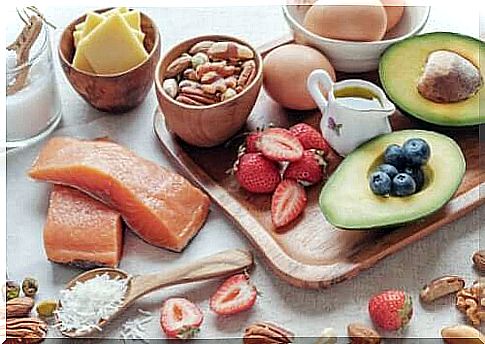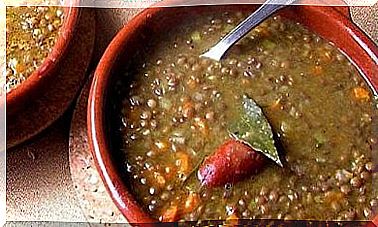Foods Allowed In The Ketogenic Diet

The foods allowed in the ketogenic diet are the subject of constant interest and research for those who are attracted to this nutritional method. This is a meal plan that has become popular in recent years due to the possible health benefits.
It has been shown to be effective for weight loss and also for reducing seizures in drug resistant patients. Its efficacy as a treatment for diabetes is currently being studied.
It is based on a simple principle: the restriction of carbohydrates. Since it eliminates an entire food group, it is not suitable for everyone. Nevertheless, those who manage to properly follow this diet observe positive changes in their body in a short time.
List of foods allowed in the ketogenic diet
The ketogenic diet is a food plan that does not allow the consumption of carbohydrates. In order not to make mistakes, you need to know the foods that can be included on a regular basis. We present them so that you have no doubts about it.
Food of animal origin
All products of animal origin are allowed under the ketogenic regime. Meat, fish, and eggs are all protein foods that form the base of the ketogenic diet pyramid.
Ensuring protein intake is essential to prevent muscle catabolism. In addition to this, it prevents the onset of sarcopenia in the medium and long term. Scientific evidence shows that the daily intake of these nutrients should exceed 0.8 grams per kilogram of body weight, which is the minimum set by the World Health Organization.
Some attention is needed in the method of food preparation. The ideal cooking mode is grilled, baked or boiled. You should avoid adding batters or breading foods, as carbohydrates would be introduced with these toppings.
Likewise, it is preferable not to fry to avoid the formation of toxic waste products that can affect health. An example of these toxins would be polycyclic aromatic hydrocarbons, which increase the risk of developing cancer, according to research published in the journal Scientific Reports . Therefore, they can be consumed:
- White meat.
- Red meat.
- White fish.
- Blue fish.
- Seafood.
- Eggs.
- Dairy products.
Foods allowed in the ketogenic diet: vegetables
Most vegetables are low in carbohydrates. They can therefore be included in the ketogenic diet. Tubers are an exception, which should be avoided or severely limited.
It should be noted that by vegetables we mean vegetables and vegetables. You should avoid consuming large quantities of fruit, as their fructose content breaks the ketosis process, which is the part of the metabolism underlying the keto plan; it consists in the production of body energy from sources other than the usual ones.
Proponents of this diet claim that fructose increases the risk of liver disease, according to recent research. It is also necessary to limit legumes, as they also contain sugars that can interfere with the metabolism of fatty acids. The vegetables to include are as follows:
- Cruciferae (cabbage, cauliflower, broccoli, cabbage, etc.).
- Celery.
- Lettuce.
- Green beans.
- Onions.
- Spinach.
- Zucchini.
- Peppers.
- Avocado.
In the preparation of these foods it is important to avoid, as with meat, batters, breading and frying. The ideal cooking is grilled or steamed. If you opt for boiling, it is advisable not to discard the cooking water in order not to lose the water-soluble vitamins.
Fat food
Among the foods allowed in the ketogenic diet we also find fats, which provide omega-3 and 6 acids, necessary for the proper functioning of the body.
The former have calmed systemic inflammation. As a result, regular intake of these nutrients reduces the risk of cardiovascular disease, according to a study published in the American Family Physician e. When we talk about fatty foods, we refer to:
- Vegetable oils.
- Oily fruits (avocado).
- Dried fruit.
These products must always be eaten raw in order to keep their nutritional values intact. Subjecting the lipids to high temperatures increases the production of trans fatty acids. According to the scientific literature, these substances have inflammatory capacities that are harmful to the body.
Drinks allowed in the ketogenic diet
When it comes to the ketogenic diet, it is also important to pay attention to the list of permitted drinks. Water is always the first choice. The ideal is to consume it natural, although occasionally you can choose the carbonated one.
Both coffee and tea are allowed, but no sugar or artificial sweeteners should be added to avoid causing pancreatic stress. You can add some milk.
In the ketogenic diet, sporadic intake of small amounts of alcohol is allowed. However, experts advise against it, as it harms health in various ways.

Example of a menu with foods allowed in the ketogenic diet
We present a sample menu with foods allowed on the ketogenic diet so that you can learn how to prepare it yourself.
Breakfast
- Cup of kefir with seeds and dried fruit.
- 2 scrambled eggs with 1/2 cup of raspberries.
Lunch
- Baked chicken legs with broccoli and peppers.
- Grilled salmon with asparagus and avocado.
Snack
- Yogurt with flax seeds and pineapple pieces.
- Turkey and cheese rolls.
Dinner
- Baked sea bass with green salad.
- Roasted pork chop with avocado and cauliflower.
Introduce a variety of foods to the ketogenic diet
It is possible to propose a very varied ketogenic diet while respecting the necessary restrictions. In case of doubts, it is advisable to consult the nutritionist who will be able to provide precise and personalized information.
B Remember that the ketogenic diet is not a one-size-fits-all plan. Some people find it difficult to adhere to this dietary model or have pathologies that affect their general state, which is why they will have to refrain from following restrictive regimes.









